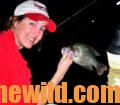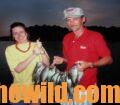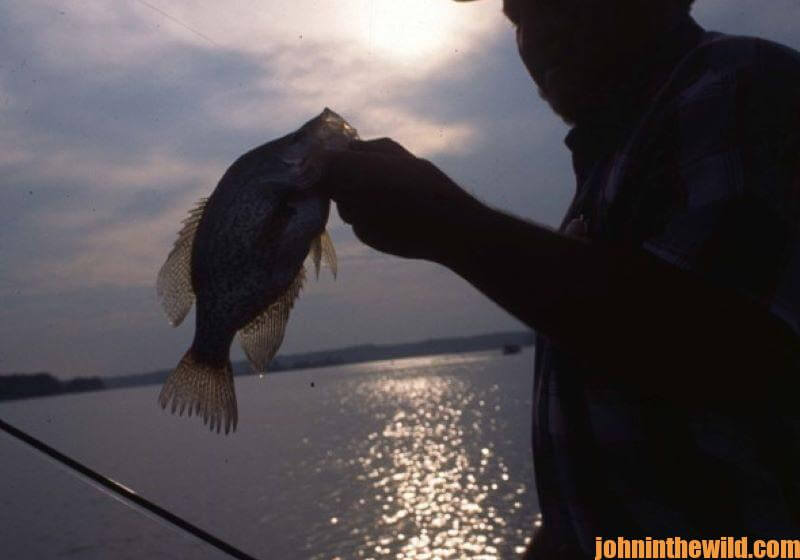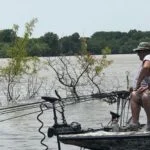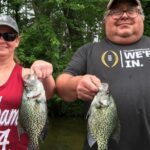Editor’s Note: Nighttime crappie fishing is one of the most addictive forms of fishing I know. Crappie fishing at night in the summer is cool, relaxing, rewarding, and an ideal way to spend quality time with friends and family away from the rest of the world. Also, crappie fishing at night doesn’t interfere with any of my daytime activities. I can fish in the afternoons after work, fish all night Friday and Saturday, and still have Sunday after church to recover.

During the summer months, crappie are looking for cool, highly-oxygenated water near structure. When the water temperature heats up, the fish often will be found on the edges of river channels or deep creek channels.
Often the very best place to locate crappie schooled-up during the summer months is on the point formed where a creek channel runs into a river channel, particularly if this spot has stumps and logs on it.
Get on the Right Road for Crappie Fishing at Night
Crappie swim down these river and creek channels much like motorists travel interstate highways. These areas are where the most baitfish will be found, and the crappie will follow the bait. When you concentrate the baitfish with a light, crappie traveling along these channels will come in to feed once they spot the light and the large numbers of baitfish there.
Bridges and railroad trestles that cross creeks, rivers, and lakes usually effectively concentrate nighttime crappie. The pilings that stand along the edges or in the middle of an underwater creek or river channels offer structure for the crappie to hold on to as well as provide a place for bait fish to hold.
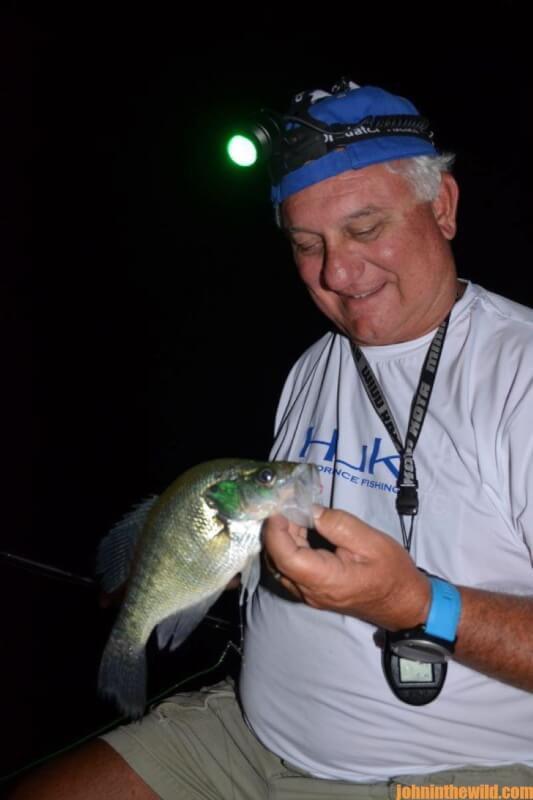
Also, generally, some current is present around pilings. The crappie can hold on to the down-current side of the pilings in the slack water and then move out into the current to feed.
The pilings offer vertical structure too, which allows the crappie to position themselves close to cover in the segment of water with the most-comfortable temperature as well as the most-dissolved oxygen.
Sometimes the areas under bridges may resemble a small village at night where boats may be lined-up under the bridges with crappie fishermen.
How the Crappie Position Themselves at Night
Generally, when crappie fishing at night, my friends and I will catch crappie from 2 feet off the bottom to 2 inches under the surface. Often the crappie will be holding right on the edge of a break near the bottom.
As the bait fish concentrate under the light closer to the surface, the crappie will move up in the water. Often you can see them swim into the light and take the bait just under the surface. So, I’ll drop my line all the way to the bottom and then count each turn of the reel off the bottom, until I get a bite.
The crappie usually will hold at one spot for some time. For instance, if I start catching crappie five turns off the bottom, then after I catch a fish next, I’ll immediately bait again, drop my line to the bottom, and reel five turns off the bottom.
When the crappie stop biting at that depth, I’ll drop my bait all the way to the bottom and begin to slowly reel up, counting the turns I’m taking on my reel as I bring my bait up toward the surface.
The longer I fish at night, usually, the higher- up in the water the crappie will be.
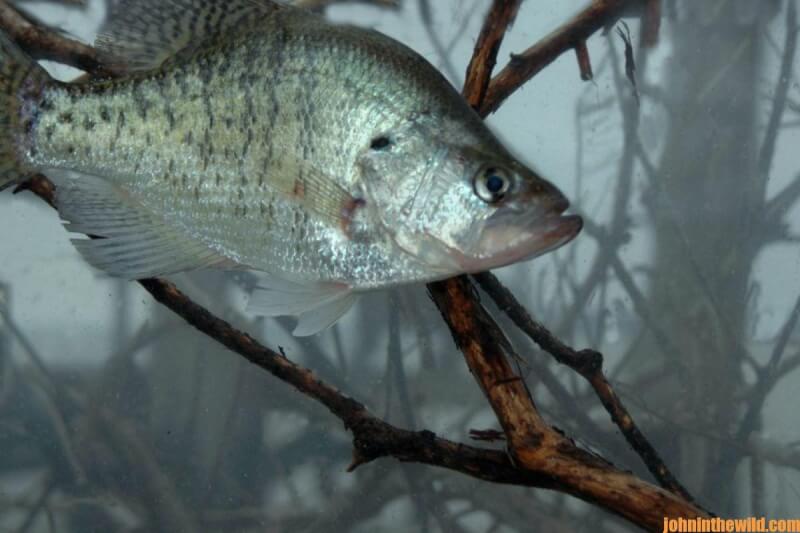
Several different schools of crappie may move under the lights at various times of the night. Often you may fish for 3-4 hours without ever getting a bite and then start catching crappie as fast as you can get baits in the water for 45 minutes to an hour.
Another hour to 1-1/2 hours may pass without your getting a bite. Then as quickly as the catching has stopped, it may begin again and often last for only 5-15 minutes or 3-4 hours.
Tomorrow: How to Fish Underwater Highways for Nighttime Crappie
When you use the links below to go to Amazon, notice on the left of the Audible option where Amazon says you can hear a sample that gives you 10% of these books for free! On the right side of the page for each book and below the offer for a free Audible trial, you can choose to Buy the Audible book.
Be sure to also check out John’s Free Books as our gift to you!
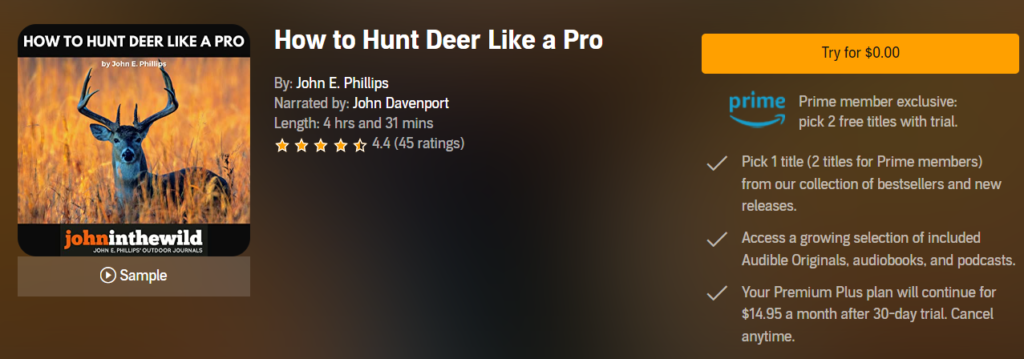
Prime Members: You’re eligible to claim 2 free titles with your 30-day Audible Premium Plus trial! Browse more than 100 of John E. Phillips’ expert guidebooks on hunting and fishing here.
Books By Topic
Category Shortcuts: View on Amazon
| Deer Hunting | Turkey Hunting | Elk Hunting | Bass Fishing |
| Mule Deer Hunting | Bowhunting | Bowfishing | Crappie Fishing |
| All Cookbooks | Hunting Cookbooks | Fishing Cookbooks | All Audible Books |
Expert Guidebooks on Crappie Fishing: Best Sellers
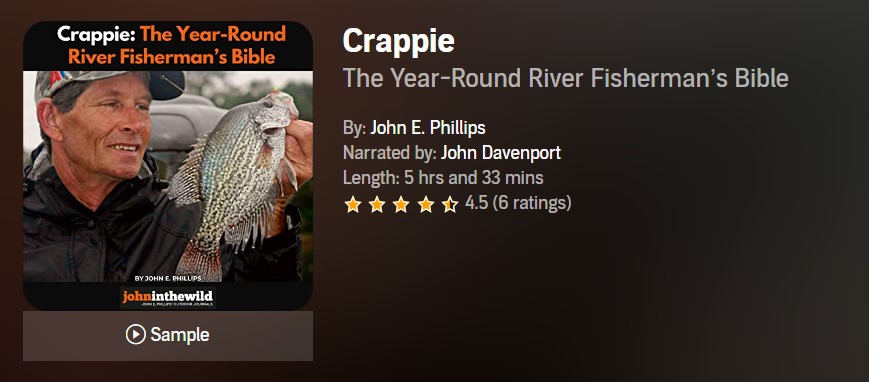
Fishing rivers for crappie and being able to find and catch speckled sides consistently has long been one of the mysteries in the crappie-fishing world.
“One of the reasons that river systems are so difficult to fish is because the water’s either rising or falling in them,” says Ott DeFoe, the 2019 Bassmaster Classic champion.
Rivers also are very susceptible to floods and droughts and constantly have current moving through them. Often fast current or slow current in rivers is created by rain or droughts upstream. When rivers flood, they can wash away fish habitat like logs, sunken trees, manmade brush piles and stake beds. But that’s the time when a river also creates new crappie hot spots that haven’t been available to the crappie or the fishermen before the flood.
Because river systems are so unpredictable, I’ve felt the best way to get the most useful information on how to fish rivers for crappie is to talk to numbers of anglers all over the nation to learn their best tactics.
In this book, I’ve gleaned crappie-fishing wisdom from three dozen crappie anglers and guides from a dozen states, who consistently catch crappie at all times of the year. The tournament crappie fishermen in this book fish most of the country at different times of the year on various river systems and lakes. And, these anglers use techniques you never may have considered, including:
- Setting up a casting ring with your electronics to keep you from getting too close to the crappie that are holding on underwater structure, while you’re fishing all the way around the structure;
- Buying an automotive laser temperature gauge to measure water temperature
- Evaluating the most-productive places to sink brush and other structure, according to prevailing wind direction, the crappie’s summer, fall, winter, and spring migration patterns, and other factors.
VERSIONS: AUDIBLE, KINDLE & PRINT
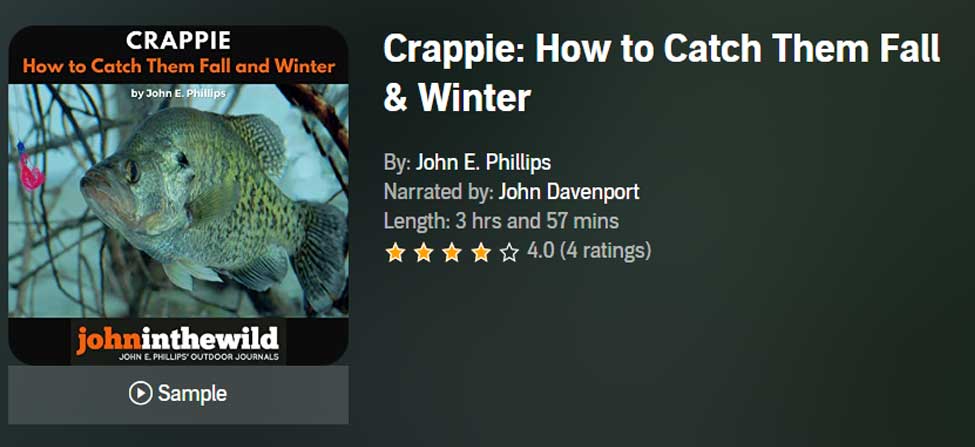
Crappie: How to Catch Them Fall & Winter
Yes, you can catch and eat crappie during the fall and winter months. Often, at many places, you’ll catch more and bigger crappies in the fall and winter than you do in the spring and summer. To learn where to find and how to catch cooler weather speckled sides, we’ve interviewed a wide variety of some of the nation’s best tournament crappie fishermen and guides.
Many of the individuals you’ll hear about in this audiobook are tournament crappie pros who travel the country to fish in crappie tournaments from New York to Florida and from Virginia to California. They use the latest crappie-finding equipment, the best poles, rods, reels, line, and the most-productive baits. Each of the people mentioned in this book has the ability to be dropped out of an airplane anywhere in the United States and catch crappie on any lake close to where they land that contains crappie.
From over 50 years of crappie-fishing experience, I’ve learned that you get the best advice by interviewing a large number of people who have different tactics and fish under various water, weather, and fishing-pressure conditions.
In this book, you will learn:
- How to spider-rig (slow-troll), which is one of the fastest-growing techniques for catching the most and biggest crappies in the shortest time
- How to catch crappie on crank baits and when and where using a crank bait is the most appropriate
- How to find areas of any lake that will hold large schools of crappies during the winter months – places you can return to time and again and expect them to be there
- Why competing in crappie tournaments is one of the quickest ways to learn how to catch more and bigger crappie faster
- Why and how to look for and catch the biggest crappie in a lake
VERSIONS: AUDIBLE, KINDLE & PRINT
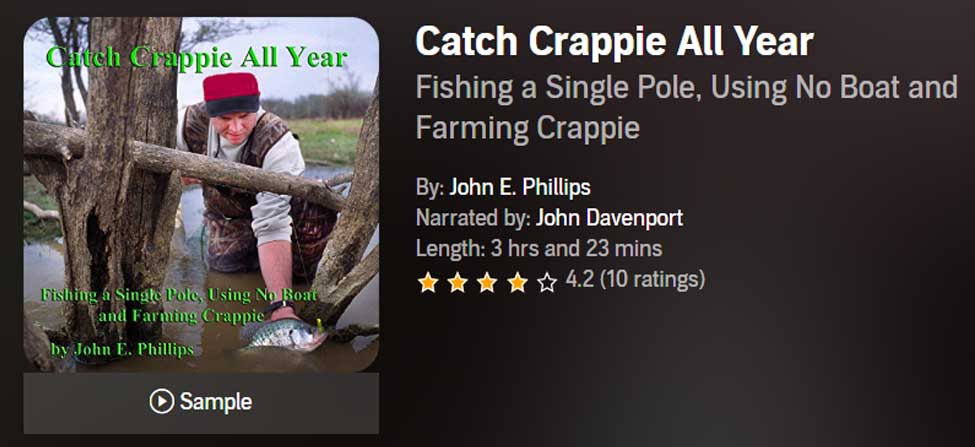
Catch Crappie All Year: Fishing a Single Pole, Using No Boat, and Farming Crappie
I’ve interviewed some of the best crappie fishermen in the nation for my new audiobook, Catch Crappie All Year: Fishing a Single Pole, Using No Boat and Farming Crappie to learn how, where, and when to catch the most crappie with or without a boat while single-pole fishing. I’ve also included information on how to grow a crop of crappie to catch every day of the year. Although I’ve fished in fully rigged crappie boats costing $45,000 – $90,000-plus that can have up to 16 rods at one time to slow troll, I still enjoy….
- Watching a quill cork sink in a brush top
- Fishing with an ultralight spinning rod
- Reeling jigs or minnows along a grass line and feeling that thud when a crappie takes the bait
- Fishing with family and friends, even if we all can’t fit in one boat
- Participating in less-expensive and hassle-free yet highly-productive crappie fishing like single poling
I’ve tried to capture in this new audiobook the old way of crappie fishing with new twists and detailed tactics to aid you in catching crappie all year.
VERSIONS: AUDIBLE, KINDLE & PRINT
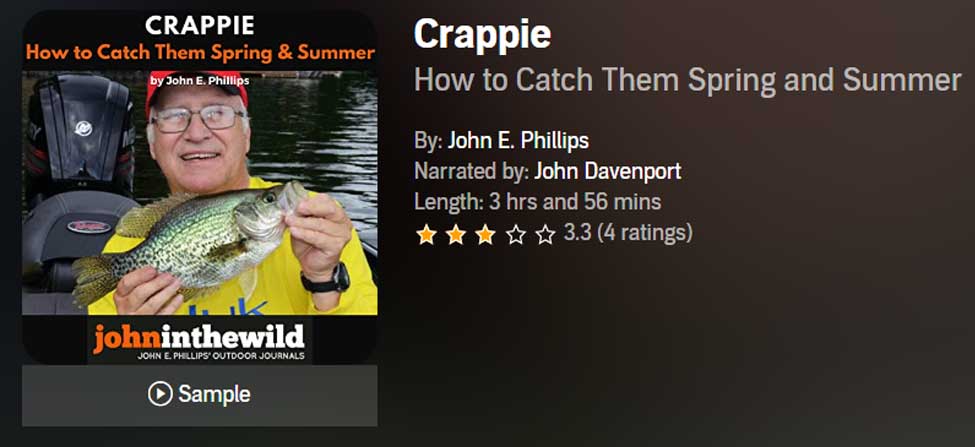
Crappie: How to Catch Them Spring and Summer
You can catch crappie all year long if you know where to find them and what techniques to use to catch them. However, crappie fishing is so technical these days, and we’ve learned so much about how to crappie fish because of the professional crappie-fishing circuits, that one book can’t hold all the information.
This book is the first of a three-part series on how, where, and when to catch crappie, with the best crappie fishermen in the nation. Many of these men have proven they are the best, because they’ve won crappie-fishing tournaments or been successful fishing guides for many years.
This audio version of Crappie: How to Catch Them Spring and Summer includes crappie pros like Ronnie Capps, who has won seven national championships and over $1 million with his partner Steve Coleman.
We also have Malcolm Lane, Stokes McClellan from North Carolina, Billy Blakeley from Reelfoot Lake, John Woods, Kent Driscoll, fishing biologist and professional basser Ken Cook, and many others. We asked the questions that crappie fishermen want answered about how to find and catch crappie during the spring and summer months, and these fishing tips are the result.
In the world of crappie fishing, no one man knows it all, and that’s why I’ve interviewed so many fishermen, asked so many questions, and tried to get so many answers for you about how to fish.
VERSIONS: AUDIBLE, KINDLE & PRINT

